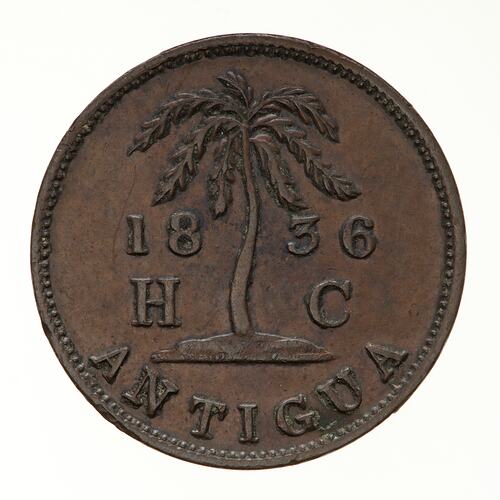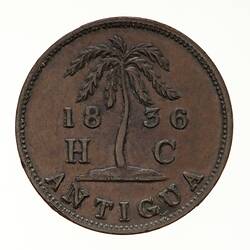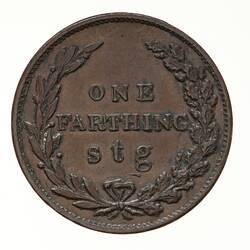Summary
Farthing token, Issued by, St. John, Antigua, 1836.
Mint not recorded.
Date on token could be date of founding of company.
Obverse Description
At centre, palm tree; below, ANTIGUA; divided by palm, 18 36 / H C
Reverse Description
At centre within wreath of oak and olive leaves, ONE / FARTHING / stg
Edge Description
plain
Significance
Antigua, an island which is located in the Caribbean Sea, was discovered by Christopher Columbus in 1453. It was settled by the English in 1632 and Charles II granted it to Lord Willoughby. Coinage on the Island was the regional standard of Spanish and French colonial issues until 1822 when the British sent a shipment of 'Anchor' Money (in the denominations of quarter, eighth and sixteenth of a Spanish dollar). In 1825 a supply of British silver and copper coins arrived but circulated at a local currency rating. In 1847, 100 pound sterling was rated at 225 pound currency but this was abolished on 13 January 1847 after which standard sterling applied. This token is denominated as sterling (stg) so its issue is placed after that date. The date on the token, 1836 is believed to be the date of the founding of the Hannay & Collart company, merchants in St. John. Antigua became an independent state on 27 February 1967, it remains within the British Commonwealth.
More Information
-
Collecting Areas
-
Acquisition Information
Transfer from National Gallery of Victoria (NGV), A.H. Baldwin & Son Ltd, 15 Mar 1976
-
Date Issued
1836 AD
-
Issued By
-
Denomination
-
Material
Bronze
-
Axis
12
-
Classification
-
Category
-
Discipline
-
Type of item
-
Dimensions
21.5 mm (Outside Diameter), 4.28 g (Weight)
-
Shape
Round
-
References
Prid.3 p.148.1 KM#Tn1
[Book] Pridmore, Fred. 1965. The Coins of the British Commonwealth of Nations, Part 3, West Indies.
[Book] Remick, Jerome. 1971. British Commonwealth Coins.
[Book] Bruce, Colin R. 2006. Standard Catalogue of World Coins 1801 - 1900.
-
Keywords


